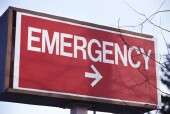One in six Americans too far from lifesaving heart centers

(HealthDay)—Tens of millions of rural, poor and Hispanic Americans do not have timely access to a lifesaving heart procedure, a new study finds.
Researchers analyzed the driving times for 306 million people to reach the closest angioplasty centers across the continental United States.
Angioplasty is used to open blocked heart arteries. A catheter is used to insert a deflated balloon into the artery. The balloon is then inflated to open the artery and restore blood flow to the heart. There are more than 1,700 angioplasty centers in the United States, the researchers said.
The median time to an angioplasty center was 33 minutes, they found. However, the median travel time for more than 16 percent of the population—about 50 million people—was 81 minutes, according to the study.
Results were published July 13 in the journal Health Services Research.
It shouldn't take longer than 120 minutes from the time a heart attack patient has first contact with medical help to the inflation of the balloon in a blocked heart artery, the American Heart Association and the American College of Cardiology recommend.
Longer travel times to angioplasty centers could lead to worse outcomes for millions of patients, said study senior author Dr. Renee Hsia, a professor of emergency medicine and health policy at the University of California, San Francisco, in a university news release.
"While our results show that the 84 percent of the continental U.S. population live within 60 minutes of a hospital with an angioplasty facility, we have to recognize that the remaining 16 percent do not have timely access to these centers, which should be reflected in pre-hospital treatment protocols to optimize other methods of management," she said.
Rural residents were more likely to have longer travel times to angioplasty centers. The researchers also found that poor and Hispanic Americans in both cities and rural areas were more likely to have poorer access to angioplasty centers.
Poor and Hispanic patients were three and 2.5 times more likely, respectively, to reach an angioplasty center more than 60 minutes after first contact with medical help.
These findings are especially significant in light of well-documented disparities and outcomes for poor and minority heart attack patients, Hsia said.
In 2000, the median distance to an angioplasty center was 7.9 miles and 79 percent of Americans lived within an hour of a center. That improved to 7.4 miles and 84 percent, respectively, in 2011, the researchers said.
While those figures suggest improved access, many new angioplasty centers have opened in areas with the lowest need—"in competitive markets, often with high private insurance penetration"—and where angioplasty services may already be present, the researchers noted.
More information: The U.S. National Heart, Lung, and Blood Institute has more about coronary angioplasty.
Copyright © 2015 HealthDay. All rights reserved.















